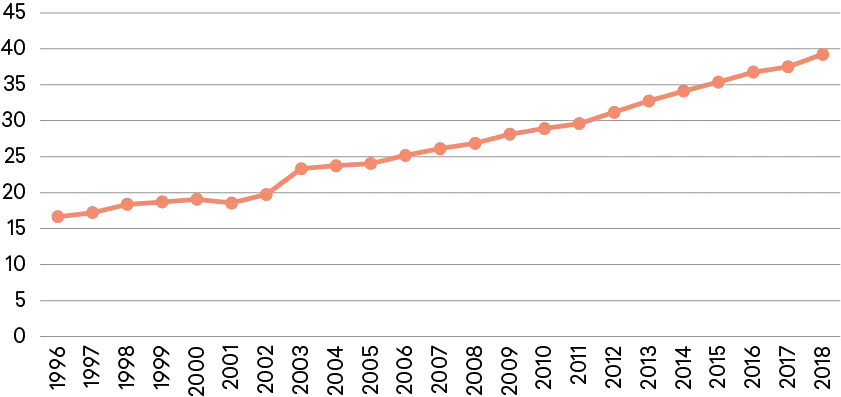Introduction

In the 1980s, physicists from around the world gathered at the European Organization for Nuclear Research (CERN), a particle physics laboratory in Switzerland, to develop and run experiments using the shared facility’s accelerators.3 However, their scientific progress was impeded by a logistical challenge: how could experimental information be widely shared across the international scientific community? In 1989, Tim Berners-Lee, a software engineer working at CERN, proposed a solution involving three Internet software technologies he had developed—HTML, URL, and HTTP—which, in 1990, would provide the foundation for the World Wide Web.4
Scientific fundamental research, technology development, and technological innovation are essential drivers of economic growth and prosperity, both at home and abroad. For the United States to continue to act as a global economic, security, and scientific leader, it must conduct and invest in the most advanced scientific research across many disciplines. To perform such research requires that scientists and engineers be increasingly involved in collaborations: the vast majority of scientific publications have multiple authors.5
International scientific collaborations have been an important element of the U.S. research and development (R&D) enterprise for decades, and U.S. scientific research is increasingly conducted with international collaborators. Since 2004, the number of international scientific research collaborations globally has tripled.6 Now, in an era of strong growth in the global R&D sector and an unavoidable diminishing U.S. share of global R&D expenditures, international scientific engagement across all disciplines and at all scales is essential. This need has been recognized by the researchers themselves.7 It must also be considered an ongoing strategic national priority and incorporated into U.S. planning and policy.
The fraction of the articles published by U.S. scientists and engineers that are coauthored with scientists from an international institution has increased rapidly since 1996 (Figure 1). This trend reflects the fact that a growing share of global R&D funds is spent outside the United States, thereby rapidly expanding and strengthening the international scientific community. For much of the latter half of the twentieth century, the United States was the world’s major R&D funder; today, the U.S. share of global R&D is estimated to have fallen to 28 percent, nearly entirely due to increases in spending in other countries.8 Today, many countries, including South Korea, Israel, Japan, and Austria, spend a greater percentage of their national GDP on R&D investment than the United States, and China is approaching U.S. overall R&D spending levels when adjusted for purchasing power parity.9 Manufacturing, chemicals, pharmaceuticals, and information technology sectors are among the top recipients of global R&D investment, and e-commerce, cloud services, and medical equipment are among the sectors with the highest rates of R&D growth.10

Source: National Science Board, Publications Output: U.S. Trends and International Comparisons (Alexandria, Va.: National Science Foundation, 2019).
As global investments in science have increased, international collaboration has risen as well: from 2000 to 2015, the percent of scientific publications worldwide produced by authors from two or more countries doubled from 10.7 percent to 21.3 percent.11 Further, this international collaboration strengthens the impact of scientific research; as one marker of this feature, U.S. science publications involving international collaborators rank considerably higher than all other U.S. science publications in field-weighted citation impact (FWCI) analyses, in some cases nearly doubling the average FWCI of publications with only collaborators from the same country.12
American scientists across disciplines seek the best collaborators for their projects, and those partners are increasingly located in foreign countries. For American scientists to collaborate effectively with scientists around the world and to maximize the benefits of international collaborations for the United States, the U.S. government must be strongly committed to fostering, supporting, and strengthening international scientific partnerships.
Defining International Scientific Partnerships
International scientific partnerships can take many forms. Collaborations take place at all scales, from a peer-to-peer collaboration between scientists in Ames, Iowa, and Nairobi, Kenya, to a large-scale scientific user facility in Switzerland enabling discoveries by thousands of participating U.S. and international scientists. International collaborations also span all scientific disciplines and approaches, such as in fundamental research, technology development, and technological innovation.
Some of these efforts are quantifiable and formal, such as research collaborations that lead to publications with coauthors from institutions in different countries. Others are more informal, such as when two graduate students from separate nations meet at a scientific conference, bond over their common scientific pursuits, and return to their home labs with fresh research ideas. These collaborations can range from very small scale, when an individual researcher deposits data into an internationally supported database, to very large scale, when thousands of researchers in a consortium tackle a major scientific challenge. This report takes a broad view of international scientific partnerships, on all scales and levels of formality, and identifies elements that are integral to successful collaboration.

In 2003, then UN Secretary General Kofi Annan sends the first message from a CERN server to students participating in the UN-sponsored World Summit on the Information Society in Geneva. © Jean-Philippe Ksiazek/Getty Images.
Imperatives for International Collaborations
The American Academy’s initiative on Challenges for International Scientific Partnerships has identified six primary factors that underlie the imperative for the United States to continue and strengthen its investments and participation in international collaboration: 1) the global nature of scientific questions; 2) competition for global talent; 3) U.S. economic competitiveness; 4) U.S. national security; 5) funding realities, particularly for large-scale science projects; and 6) the development and application of international ethical norms and scientific guidelines. The following sections address each of these imperatives in turn.